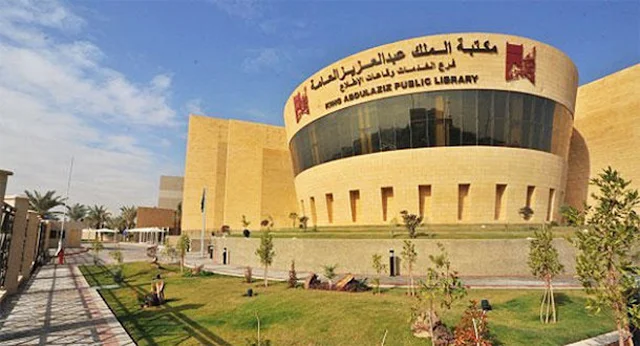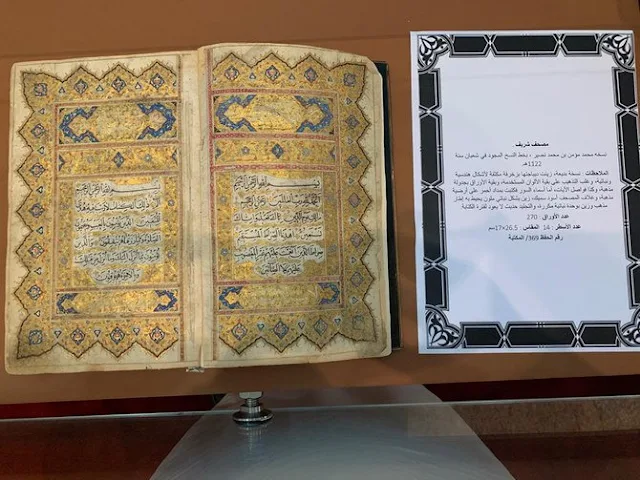The Kingdom of Saudi Arabia attaches great importance to the preservation of documents and manuscripts, believing in the great heritage value they represent.
It preserves and documents the history of the Kingdom, in addition to enhancing the civilizational role that the Saudis are trying to promote through their possession of the tools of enlightenment and cultural radiation in the region.
During the last two decades, in particular, Riyadh has made strenuous efforts to preserve manuscripts and collect the largest possible number of them from various libraries in the world.
It established specialized centers to archive and preserve these manuscripts, led by the King Fahd National Library, the King Abdulaziz Public Library, and the King Faisal Center for Research and Islamic Studies, in addition to the National Center for Documents and Manuscripts.
In this report, we shed light on the efforts of the Kingdom - which ranks fifth in the classification of countries that own manuscripts in the Islamic world - in possessing manuscripts and heritage documents, how to preserve them, and the most prominent reservoirs prepared for this and the precious treasures they contain.
 |
| King Faisal Center for Research and Islamic Studies |
27% of Arab and Muslim manuscripts
In his study of Saudi Arabia’s efforts to preserve manuscripts, Abdul Karim bin Abdul Rahman Al-Zaid, assistant professor of libraries and information at Imam Muhammad bin Saud Islamic University, deputy general supervisor of the King Abdul Aziz Public Library in Riyadh, says:
His country owns more than 27% of the total original Arabic and Islamic manuscripts in the Arab countries.
He explained through the study that during the past fifty years, the Kingdom has made great efforts in collecting original manuscripts, restoring them, and issuing printed catalogs for them.
This is done through Saudi universities, libraries, and specialized centers, indicating that the Saudi government has spared no effort in this national project.
The study used the King Abdulaziz Public Library in Riyadh as a model to study these efforts, which succeeded in providing 150,000 original manuscripts and approximately 188,000 manuscripts illustrated on papers or films, covering the period from the fourth century AH to the thirteenth century, in addition to hundreds of other rare works.
The study also explained the steps taken by Riyadh to preserve and protect manuscripts, as it established its own sections in most Saudi Arabian libraries.
This is in addition to restoration and maintenance laboratories using the latest technologies, in addition to creating postgraduate programs on manuscripts to encourage the process of scientific research in this vital field.
Arab and Islamic manuscripts - according to the Saudi study - have always been subjected to destruction and damage due to internal strife and sectarian differences, in addition to colonialism, which toppled dozens of libraries.
This is in addition to illiteracy, which was a major reason for the weak interest in manuscripts in the Arab world.
King Fahad National Library
The King Fahad National Library in Riyadh represents a heritage beacon of great stature, as it is the largest treasury of Saudi manuscripts.
It contains about 80,000 manuscripts, 6,000 of which are original, and 74,000 are photographed and archived.
Year after year, the library witnesses amazing developments in this path, making it one of the most famous heritage libraries in the Arab region.
The library, which was established in 1407 AH / 1986 AD at the initiative of the people of the city of Riyadh to celebrate the accession of King Fahd bin Abdulaziz to power in 1983 AD - is located in the center of the Saudi capital, Riyadh.
On an area of approximately 58 thousand square meters, 30 thousand square meters of which were allocated to the garden and a large walkway to the main building with an area of 28 thousand meters.
The building's surface area is 23 thousand square meters, and with the increase in the number of manuscripts in the library, it was expanded until it reached 87 thousand square meters.
The rulers of the Kingdom paid great attention to the library and lavished grants and gifts until it became a beacon entrusted with preserving and protecting the Saudi heritage in particular and the Arab and Islamic heritage in general.
Rather, over time, it became the main library in the Kingdom, despite dozens of other libraries, some of which have a larger area.
The library possesses many rare manuscripts, including: “Zad al-Ma’ad” manuscript by Ibn al-Qayyim in the handwriting of Suleiman bin Abdullah bin Sheikh Muhammad bin Abdul Wahhab, which was written in 1220 AH/1806 AD in Naskh script and contains letters and fatwas of the Imams of the Call in Najd, as well as some precious Qur’ans.
Among them is a Kufic Qur’an written on parchment, dating back to the third century AH.
There is a complete Safavid Qur’an, a Mamluk Qur’an, and an Andalusian Qur’an. The library also maintains three manuscripts written on papyrus, one of which dates back to the third century AH.
Regarding ways to preserve these manuscripts and protect them from damage, the Secretary General of the Library confirmed that it follows a solid system that protects the safety of manuscripts from pests and that it also has a center for restoration and sterilization.
The library is full of microfilm images of some manuscripts in American libraries, such as the Berentson University Library. As well as the holdings of the Jewish University Library, which number 1,140 manuscripts.
King Salman bin Abdulaziz, when he was governor of the Riyadh region, also ordered the transfer of the 792 manuscripts of the Saudi “Dar Al-Ifta” library to the King Fahd Library.
In an interview with the Saudi newspaper Asharq Al-Awsat, the Secretary-General of the Library, Mohammed bin Abdulaziz Al-Rashed, explained that the King Fahd Library is responsible for preserving the Saudi national heritage.
It also possesses many important sources of information from the Kingdom’s heritage, such as books, university theses, and periodicals. It also contains more than 70,000 photos documenting the country’s history.
Among the important contents that the library possesses - according to Al-Rashed - are the endowments of the princes of the Al Saud and others for books.
Among the most prominent endowments it contains are the endowments of Turki bin Abdullah, Faisal bin Turki, Abdullah bin Faisal, Muhammad bin Faisal, and Abdul Rahman bin Faisal.
In addition to the endowments of King Abdulaziz Al Saud, women's endowments include Al-Jawhara bint Turki bin Abdullah, Sarah bint Turki bin Abdullah, Munira bint Mishari, Noura bint Imam Faisal, Al-Jawhara bint Imam Faisal, and others.
Regarding ways to preserve these manuscripts and protect them from damage, the Secretary General of the Library confirmed that it follows a solid system that protects the safety of manuscripts from pests.
It also has a restoration and sterilization center, which is one of the most prominent centers in the region, in addition to the good administrative and office system that allows us to benefit from this great heritage without damaging it or exposing it to danger.
 |
| King Fahad National Library |
King Abdulaziz Public Library
Only one year after the inauguration of the King Fahd National Library, the royal decision came to approve the establishment of the King Abdulaziz Public Library in 1987.
To be a new platform for preserving Saudi heritage and protecting manuscripts from damage and deterioration due to the high-quality and advanced technical mechanisms and tools provided with them.
The library owns more than 12,000 manuscripts, including 6,500 original manuscripts.
It has also succeeded in converting this enormous heritage treasure into a digital format that makes it easier for researchers, readers, and those interested to review and access it.
More than two million pages of these digitized manuscripts were made available on the Internet, which made it easier for researchers inside and outside the Kingdom to view the manuscripts contained therein.
 |
| King Abdulaziz Public Library |
The King Abdulaziz Library is an important source of Saudi history, especially about the relationship of the founding king with science and knowledge.
The books in the library are divided into three sections: a section for books printed at the expense of the founding king, a section for books dedicated to him, and another section for rare manuscripts.
The library is one of the treasures of knowledge that contains the rarest manuscripts in history, the most prominent of which is the original copy of “Kalila and Dimna” written in the Abbasid era.
Since its founding, the library has established a special section for manuscripts, written, photographed, and digital, containing thousands of rare works.
There are many other treasuries of knowledge that contain the Kingdom’s manuscripts, including the King Faisal Center for Research and Islamic Studies, which contains more than 28 thousand manuscripts.
Two years ago, the library issued a book entitled “Manuscript Index,” which presents data on the original manuscripts owned by the library.
The first part began with recording only 300 manuscripts, with a similar number being recorded in each part.
There are many other treasuries of knowledge that contain the Kingdom’s manuscripts, including the King Faisal Center for Research and Islamic Studies, which contains more than 28 thousand manuscripts documenting the historical period between the second century AH and the fourteenth century.
The center has recently witnessed development work on tools for preservation, restoration, and digital photography, in addition to holding many exhibitions through which it aims to introduce manuscripts, shed light on them, and highlight their historical and cultural value.
While providing innovative solutions to preserve them from damage and protect them from any damages that threaten their viability.


